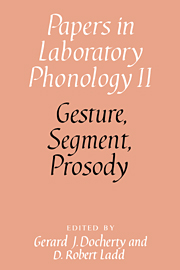Book contents
- Frontmatter
- Contents
- List of contributors
- Acknowledgments
- Introduction
- Section A Gesture
- Section B Segment
- Section C Prosody
- 13 An introduction to intonational phonology
- 14 Downstep in Dutch: implications for a model
- 15 Modeling syntactic effects on downstep in Japanese
- 16 Secondary stress: evidence from Modern Greek
- Appendix 1 The test phrases (bold type) of experiment 1 in the context in which they were read
- Appendix 2 The distractors (bold type) of experiment 1 in the context in which they were read
- Appendix 3 The test sentences of experiment 2. The test words are in bold type
- Appendix 4 The distractor sentences of experiment 2. The distractors are in bold type
- References
- Name index
- Subject index
13 - An introduction to intonational phonology
from Section C - Prosody
Published online by Cambridge University Press: 18 December 2009
- Frontmatter
- Contents
- List of contributors
- Acknowledgments
- Introduction
- Section A Gesture
- Section B Segment
- Section C Prosody
- 13 An introduction to intonational phonology
- 14 Downstep in Dutch: implications for a model
- 15 Modeling syntactic effects on downstep in Japanese
- 16 Secondary stress: evidence from Modern Greek
- Appendix 1 The test phrases (bold type) of experiment 1 in the context in which they were read
- Appendix 2 The distractors (bold type) of experiment 1 in the context in which they were read
- Appendix 3 The test sentences of experiment 2. The test words are in bold type
- Appendix 4 The distractor sentences of experiment 2. The distractors are in bold type
- References
- Name index
- Subject index
Summary
Introduction
The assumption of phonological structure is so deeply embedded in instrumental phonetics that it is easy to overlook the ways in which it directs our investigations. Imagine a study of “acoustic cues to negation” in which it is concluded, by a comparison of spectrographic analyses of negative and corresponding affirmative utterances, that the occurrence of nasalized formants shows a statistically significant association with the expression of negation in many European languages. It is quite conceivable that such data could be extracted from an instrumental study, but it is most unlikely that anyone's interpretation of such a study would resemble the summary statement just given. Nasalized formants are acoustic cues to nasal segments – such as those that happen to occur in negative words like not, nothing, never (or non, niente, mai or n'e, n'ikto, n'ikogda, etc.) – rather than direct signals of meanings like “negation.” The relevance of a phonological level of description – an abstraction that mediates between meaningful units and acoustic/articulatory parameters – is taken for granted in any useful interpretation of instrumental findings.
Until recently, the same sort of abstraction has been all but absent from instrumental work on intonation. Studies directly analogous to the hypothetical example have dominated the experimental literature, and the expression “intonational phonology” is likely to strike many readers as perverse or contradictory.
- Type
- Chapter
- Information
- Gesture, Segment, Prosody , pp. 321 - 334Publisher: Cambridge University PressPrint publication year: 1992
- 7
- Cited by

